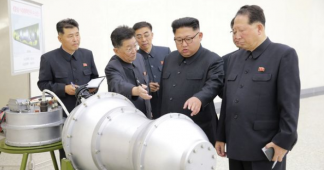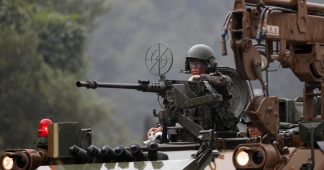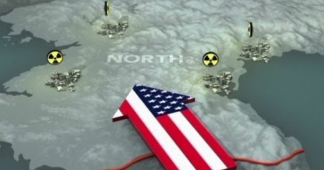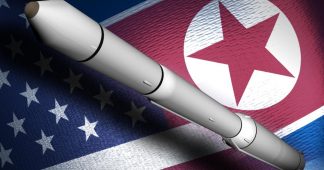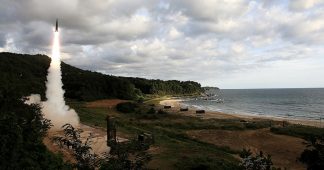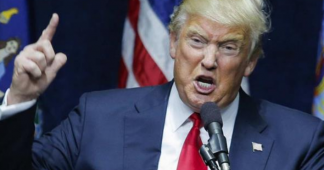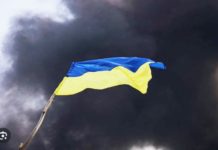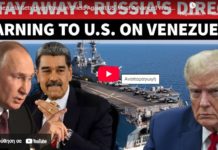By Peter Symonds
29 November 2017
North Korea test fired a long-range missile today that appears to have the range to potentially hit most parts of continental United States, including its capital Washington DC. The test took place amid high tensions on the Korean Peninsula stoked by the Trump administration’s threats to use military force to destroy North Korea’s nuclear and missile facilities.
North Korea fired the intercontinental ballistic missile (ICBM) at about 3 am local time from around Pyongsong, a town northeast of the capital Pyongyang. It flew on a lofted trajectory for about 53 minutes, reaching an altitude of around 4,500 kilometres and landing 960 kilometres away to the north of Honshu, Japan’s largest island.
If the ICBM had been fired at an angle designed for maximum distance, the range is estimated at more than 12,500 kilometres, placing the US east coast and Washington DC potentially within its reach. Whether the missile can carry a heavy payload, such as a nuclear warhead, over that distance is unknown.
Two similar North Korean ICBMs tested in July remained aloft for 37 minutes and 47 minutes respectively. A US intelligence official told Reuters the initial indications were that the missile engine was not significantly more powerful than the previous Hwasong-14 tests.
David Wright from the Union of Concerned Scientists suggested in a blog that North Korea simply lightened the missile’s payload. “If true, that means it would not be capable of carrying a nuclear warhead to this long distance, since such a warhead would be much heavier,” he wrote.
Doubts also remain as to whether North Korea has developed a re-entry vehicle capable of shielding a nuclear payload from the intense heat and pressures generated when it re-enters the earth’s atmosphere from outer space. According to Japanese Defence Minister Itsunori Onodera, the missile broke up before landing in Japan’s exclusive economic zone.
US President Donald Trump made a relatively muted response at a press conference with Defence Secretary James Mattis. “We will take care of it,” Trump told reporters. “It is a situation that we will handle.”
Mattis declared that the missile “went higher, frankly, than any previous shots.” He continued: “The bottom line is it’s a continued effort to build a … ballistic missile threat that endangers world peace, regional peace and certainly the United States.”
However, the chief responsibility for inflaming tensions in North East Asia lies with US imperialism. Trump’s administration, following on from President Obama’s, has tightened the noose of crushing economic and diplomatic sanctions around North Korea and made clear that only Pyongyang’s complete capitulation to US demands will prevent a war.
Following North Korea’s nuclear test in early September, Trump threatened at the United Nations to “totally destroy” the country. The remark highlights the vast disparity between the US, which has the world’s most powerful military and thousands of nuclear warheads, and North Korea, which has a very limited nuclear arsenal and delivery systems.
The US has provocatively staged a series of large-scale military drills with South Korea, Japan and other allies throughout 2017. Earlier this month, the US navy held an exercise involving three American aircraft carriers, along with their accompanying strike groups of destroyers and cruises, and various South Korean vessels.
The latest war games, due to commence on Saturday, involve a massive display of air power. Known as Vigilant Ace, the air drill will involve 230 aircraft, including six F-22 Raptor stealth fighters, and 12,000 US military personnel. Its purpose, according to the US military, is to enhance interoperability between US and South Korean forces and “increase the combat effectiveness of both nations.” In other words, the intent is to prepare for war with North Korea.
Following today’s ICBM test by North Korea, US Secretary of State Rex Tillerson declared: “Diplomatic solutions remain viable and open for now. The United States remains committed to finding a peaceful path to denuclearisation and to ending belligerent actions by North Korea.” He announced that the US and Canada would convene an international meeting next year to discuss how to counter North Korea.
However, the Trump administration has repeatedly rejected calls by China and Russia to pave the way for negotiations through a so-called freeze-for-freeze—suspending US and South Korean joint war games in return for North Korea halting its nuclear and missile tests.
Moreover, Trump last week reinstated North Korea to the US State Department’s list of state sponsors of terrorism in a move calculated to undermine any attempt to start negotiations. The Bush administration removed Pyongyang from the list in 2008 as part of US commitments contained in a denuclearisation deal signed in 2007. Just months later, President Bush sabotaged the deal by demanding more intrusive inspection procedures.
North Korea reacted angrily to Trump’s announcement, declaring that the decision to relist it as a sponsor of terrorism was “a serious provocation and violent infringement” of its sovereignty. Today’s missile test—the first of any type since September—is another indication that Pyongyang judges that the US cannot be trusted to negotiate in good faith.
The latest missile launch can only heighten tensions in North East Asia. South Korea responded six minutes later with its own show of force—the simultaneous test firing of a “precision” barrage of missiles from its army, navy and air force. All the missiles were calibrated to the distance to the North Korean test site, but fired into waters between South Korea and Japan.
Japanese Prime Minister Shinzo Abe, who has backed Washington’s aggressive stance toward North Korea to the hilt, spoke to Trump by phone. In comments to reporters, he called for a meeting of the UN Security Council, which is due to hold an emergency session on the launch Wednesday (US time).
The Trump administration’s policy of “maximum pressure” is not aimed just against North Korea, but also China, which is being pressured by the US and its allies to enforce what amounts to a complete economic blockade. The result is a highly dangerous situation in which any incident or accident could precipitate a catastrophic war.
